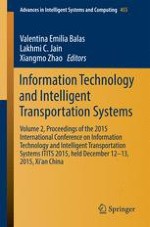This volume includes the proceedings of the 2015 International Conference on Information Technology and Intelligent Transportation Systems (ITITS 2015) which was held in Xi’an on December 12-13, 2015. The conference provided a platform for all professionals and researchers from industry and academia to present and discuss recent advances in the field of Information Technology and Intelligent Transportation Systems. The presented information technologies are connected to intelligent transportation systems including wireless communication, computational technologies, floating car data/floating cellular data, sensing technologies, and video vehicle detection. The articles focusing on intelligent transport systems vary in the technologies applied, from basic management systems to more application systems including topics such as emergency vehicle notification systems, automatic road enforcement, collision avoidance systems and some cooperative systems. The conference hosted 12 invited speakers and over 200 participants. Each paper was under double peer reviewed by at least 3 reviewers. This proceedings are sponsored by Shaanxi Computer Society and co-sponsored by Chang’an University, Xi’an University of Technology, Northwestern Poly-technical University, CAS, Shaanxi Sirui Industries Co., LTD.
